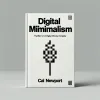"Digital Minimalism: Choosing a Focused Life in a Noisy World" is a book by Cal Newport, which explores the concept of minimizing distraction from digital tools to maximize personal satisfaction. The author advocates for a philosophy where technology is used only to support one's goals and values, rather than dictate the pace and direction of one's life. Newport provides a practical framework for achieving this through various strategies and philosophies that encourage a more intentional approach to technology use.
Analysis
Theoretical Foundations
1. Technology and Psychology:
"Digital Minimalism" is based on the understanding that the intersection of technology and psychology exploits human vulnerabilities. Tech companies design apps and devices that tap into the brain's reward centers, creating addictive behaviors. Newport’s philosophy counters this by advocating a thoughtful use of technology, focusing on quality over quantity.
2. Minimalist Philosophy:
Rooted in minimalist thought, which emphasizes the importance of paring down to essential elements, digital minimalism applies this to digital consumption. This philosophy suggests that by reducing our digital clutter, we can focus more on what brings value and joy to our lives, thus enhancing our mental and emotional well-being.
Practical Applications
1. The 30-Day Digital Declutter:
This is a practical exercise suggested by Newport, where individuals remove non-essential digital tools for 30 days. After this period, they reintroduce tools only if they provide real value. This process is not just about cutting down but about intentional usage, which is a key practice of mindfulness.
2. Solitude and Deep Work:
Newport emphasizes the importance of solitude, which he defines as time spent without input from other minds. Digital minimalism advocates for structured time away from digital distractions, allowing for deeper thought, creativity, and productivity—linking closely to Newport’s earlier work on deep work.
Societal Implications
1. Social Relationships:
Digital minimalism suggests that shallow online interactions, like likes and comments on social media, are poor substitutes for real conversations and relationships. By reducing these superficial contacts and focusing on deeper interactions, individuals can foster more meaningful relationships.
2. Attention Economy:
The philosophy challenges the prevailing business model of the tech industry, which Newport terms the "attention economy." This economy thrives on capturing and selling user attention. Digital minimalism encourages individuals to reclaim their attention and, by extension, their time and autonomy.
Conclusion
Digital Minimalism isn’t just a personal productivity strategy but a comprehensive approach to living well with technology. It addresses the psychological, social, and cultural dimensions of our digital lives. By advocating for a mindful, minimalist approach, Newport isn't just suggesting a way to use technology more effectively; he's proposing a fundamental shift in how we engage with the digital world.
This paradigm shift requires both individual and collective action and has the potential to change not only how we interact with technology but also how technology is designed and marketed. As digital tools become even more pervasive, the principles of digital minimalism might become crucial in ensuring these tools enhance rather than detract from quality of life.
Chapter Summaries
Chapter 1: A Lopsided Arms Race
- The addictive nature of smartphones and social media.
- The design of technology to maximize user engagement, not user benefit.
- Strategies to recognize and combat the urge to check devices compulsively.
This chapter sets the stage by discussing how tech companies design their products to be addictive, creating a "lopsided arms race" between their goals (user engagement) and the individual's goals (happiness, satisfaction). Newport emphasizes the importance of recognizing these design intentions to take proactive steps toward digital minimalism.
Chapter 2: Digital Minimalism
- Definition and principles of digital minimalism.
- Importance of a 30-day "digital declutter" process.
- Choosing technologies that align directly with one's values.
Newport defines digital minimalism and explains it as a philosophy that helps individuals focus on what's important by cutting out digital noise. He introduces the concept of the "digital declutter," a 30-day period where individuals reassess their technology use and eliminate what's not critical to their personal values.
Chapter 3: The Digital Declutter
- How to conduct a digital declutter.
- Steps to evaluate each digital tool's value.
- Reintroducing technology mindfully.
The mechanics of conducting a digital declutter are detailed in this chapter. Newport guides readers through the process of temporarily eliminating nonessential technologies, then carefully reintroducing tools that provide true value, aligning technology use with personal values and goals.
Chapter 4: Spend Time Alone
- Valuing solitude and time away from digital communication.
- Practices like long walks, journaling, and routine solitude.
Newport discusses the importance of solitude and being alone with one's thoughts without digital interruptions. This chapter encourages developing comfort with solitude through activities that help one reflect, relax, and regain focus.
Chapter 5: Don’t Click “Like”
- The superficiality of "likes" and digital approvals.
- Focusing on more meaningful, real-world interactions.
Here, Newport critiques the shallow interactions encouraged by social media platforms, such as the "like" button, and encourages deeper, more meaningful personal interactions that contribute to real satisfaction and genuine relationships.
Chapter 6: Reclaim Leisure
- Importance of quality leisure activities over digital entertainment.
- Encouragement to take up skillful hobbies and spend time in nature.
This chapter promotes the idea that engaging in high-quality, fulfilling leisure activities can greatly enhance personal life, acting as a powerful counterbalance to digital distractions.
Chapter 7: Join the Attention Resistance
- Using technology on your own terms.
- Tools and strategies to safeguard your attention, like turning off notifications and scheduling internet blocks.
Newport calls for active resistance against the economy of attention extraction. He offers practical tools and strategies for individuals to take control of where their attention goes, suggesting that managing one’s focus is essential in the digital age.
Key Takeaways and Insights
📵 Practice Time Away from Screens: Regularly schedule time each day where no digital devices are allowed. This helps to foster a deeper connection with the present moment and with those around you.
🌿 Engage in High-Quality Leisure Activities: Replace passive digital consumption with activities that require more active engagement or creativity, such as hobbies that involve crafting, playing a musical instrument, or gardening.
📚 Prioritize Solitude: Make time for solitude away from digital noise. Solitude allows for self-reflection and can lead to greater self-awareness and personal growth.
🔕 Turn Off Notifications: Minimize distractions by turning off non-essential notifications on all digital devices. This simple action can reduce the compulsive urge to check your phone.
🗓 Schedule Your Social Media Time: Instead of sporadic and frequent checks throughout the day, schedule specific times to access social media. This helps manage time and maintains focus on tasks without constant interruption.
🤝 Cultivate Real Conversations: Prioritize face-to-face interactions over digital ones. Encourage more in-person meetings or phone calls instead of texts or emails when possible.
🛠 Reassess Your Tool Use: Regularly evaluate each digital tool you use, including apps and services, to determine whether it contributes or detracts from your well-being, productivity, and personal values.
🔄 Perform a Digital Declutter: Consider conducting a digital declutter every few months where you remove unnecessary digital tools and apps from your life for a period of 30 days. Afterward, reintroduce only those tools that you find truly valuable.
📉 Minimize Digital Footprints: Be selective about the digital platforms you engage with. Less is often more when it comes to online presence if it means you can concentrate on what is truly beneficial or enriching.
🛌 Establish Tech-Free Zones: Create physical areas in your home, such as the bedroom or dining room, where digital devices are not allowed. This promotes better sleep hygiene and more quality family time.
These insights from "Digital Minimalism" encourage a thoughtful and strategic approach to technology, aiming to ensure that digital tools enhance rather than control our lives and careers.
Audience
"Digital Minimalism" is primarily aimed at:
- Technology Users Feeling Overwhelmed: Individuals who feel overwhelmed by their constant connectivity to digital devices and social media platforms and are looking for a way to regain control over their digital lives.
- Productivity Seekers: People interested in enhancing their productivity and focus, both in their personal and professional lives, through more disciplined and purposeful use of technology.
- Wellness Advocates: Those concerned with mental health and seeking strategies to improve their overall well-being by reducing digital stress and creating more space for meaningful offline interactions.
- Lifestyle Optimizers: Readers looking to declutter not just their physical spaces but also their digital environments, aiming for a lifestyle that promotes real-world interactions and experiences over virtual ones.
Newport's approach appeals to anyone who is reassessing their relationship with technology, especially those who sense that their current patterns of digital engagement might be detracting from rather than enhancing their quality of life.
Alternative books
- "Irresistible: The Rise of Addictive Technology and the Business of Keeping Us Hooked" by Adam Alter - This book delves into why our screens are so addictive and what this means for our social and psychological well-being.
- "The Shallows: What the Internet Is Doing to Our Brains" by Nicholas Carr - Carr explores how the Internet is influencing the way we think, read, and remember, suggesting that the medium is reshaping our neural pathways.
- "Indistractable: How to Control Your Attention and Choose Your Life" by Nir Eyal - Eyal provides insights and tools to control your attention and manage distractions, building on his background in behavioral design.
- "Deep Work: Rules for Focused Success in a Distracted World" by Cal Newport - Another book by Newport, focusing on the benefits of deep work and offering practical advice for cultivating focus and minimizing distractions.
- "Hooked: How to Build Habit-Forming Products" by Nir Eyal - Though it's about designing products that capture people’s attention, reading it can also provide insights into resisting these designs in personal technology use.
- "Mindful Tech: How to Bring Balance to Our Digital Lives" by David M. Levy - Levy explores how we can use mindfulness techniques to bring balance to our digital lives, encouraging more conscious interaction with technology.
- "Reclaiming Conversation: The Power of Talk in a Digital Age" by Sherry Turkle - This book stresses the importance of face-to-face conversation in digital times and how stepping away from screens can foster deeper, more meaningful relationships.
- "Essentialism: The Disciplined Pursuit of Less" by Greg McKeown - While not exclusively about digital minimalism, this book promotes the idea of doing less but better in all aspects of life, including our digital habits.
- "Bored and Brilliant: How Spacing Out Can Unlock Your Most Productive and Creative Self" by Manoush Zomorodi - Zomorodi challenges the reader to disconnect from digital devices to harness boredom as a path to creativity and productivity.
- "How to Break Up with Your Phone: The 30-Day Plan to Take Back Your Life" by Catherine Price - This practical guide offers a step-by-step plan for taking a break from your phone to reset your habits and improve your life quality.
These books offer various perspectives and strategies to manage and understand the impact of digital technology on our lives, encouraging more intentional and beneficial engagements with our devices.


